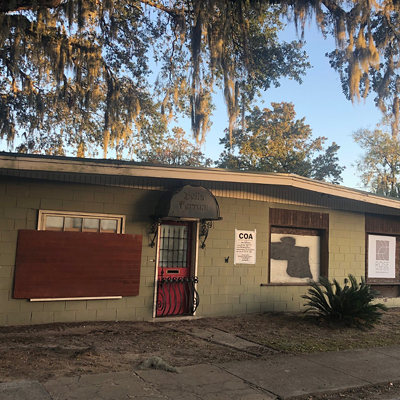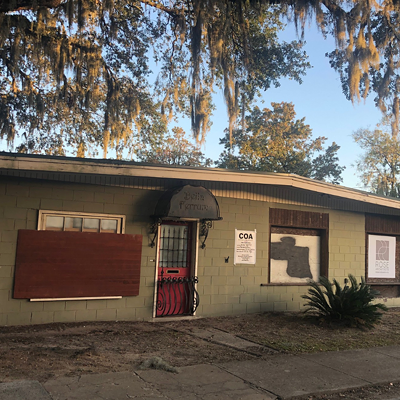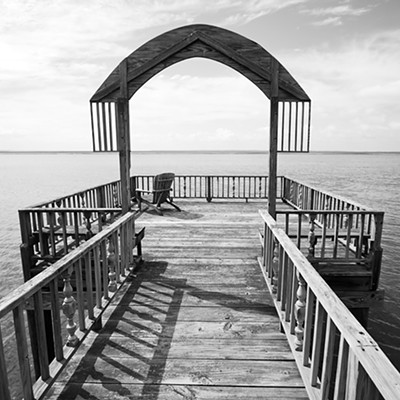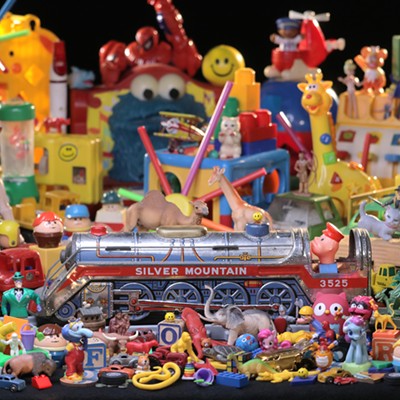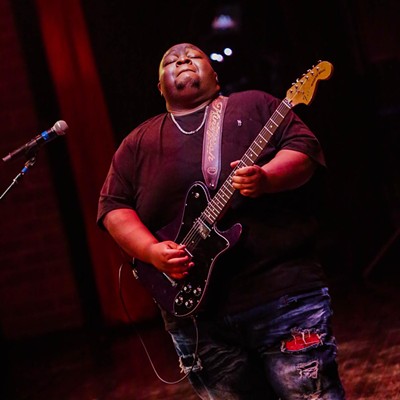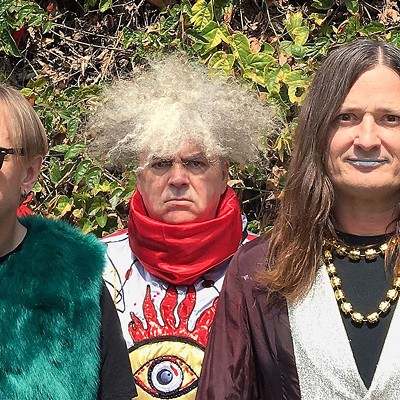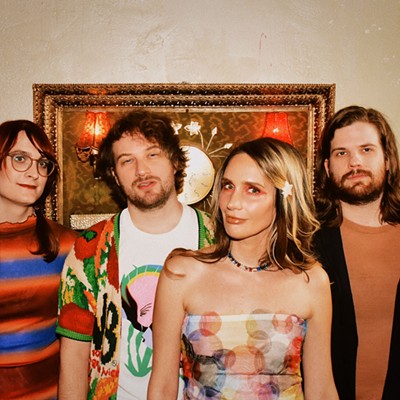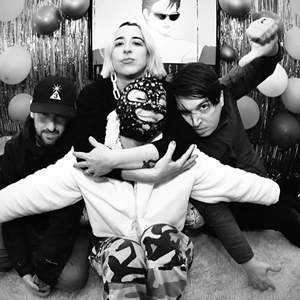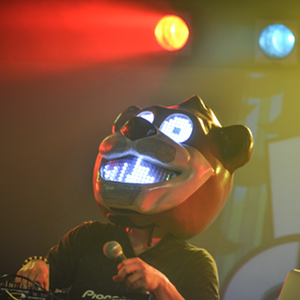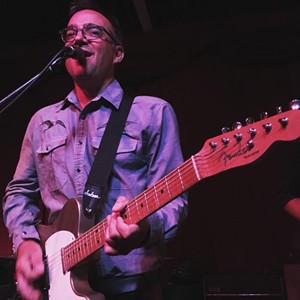FOR AS LONG AS THERE HAVE BEEN live music scenes, there have been photographers who have attempted to document them for posterity. However, up till now, most of the published shots one was likely to find of Savannah concerts would be decades old, focused on the jazz world, and reproduced in historic tomes.
However, that is about to change.
In what may seem a strangely overdue development, one former SCAD student has just completed his first book (as both author and photographer), and it chronicles a two year period in our local rock scene. The DFL Project limits itself to coverage of shows which took place within the confines of 127 West Congress St., a roughly 120-person capacity room which has to date housed two different (but complementary) music venues, the now-defunct Velvet Elvis and The Jinx.
Since 1993, between the two clubs, that space has served as the epicenter of Savannah’s punk and metal communities, hosting shows by well-known acts from both here and abroad. It’s also served as a home base for local groups in those genres, some of whom have gone on to national and even international acclaim.
In anticipation of this Saturday’s book release and signing —which also features a special reunion set from long-gone local punk legends The Bricks— I spoke with author Brandon Schaffner about the The DFL Project, as well as his plans for future volumes.
Besides photograpy, what do you do?
Brandon Schaffner: I work at SCAD doing web design and in their photo lab.
Is this your first book?
Brandon Schaffner: Yes it is. It’s also the first major project I’ve worked on.
What does “DFL” stand for?
Brandon Schaffner: It’s an abbreviation for “down for life”. I realize some people when they see it, read it as “dead fucking last.” (laughs) It’s kind of an old sarcastic punk rock phrase you hear people use.
When were these pictures actually shot?
Brandon Schaffner: I basically shot for ten months, and then spent the next two years editing the book. The first section was shot while I was still in college in 2003 or 2004.
At what point did you realize these photographs might make an interesting book?
Brandon Schaffner: In September of 2005. I decided to do a book as opposed to a show, because with fine art prints, there’s only one of each, and they’re pretty expensive. I thought a book would be much more accessible, and not only would it include a lot more images, I could put a price on it anyone would be able to afford.
If you had planned all along to use these in a book, would you have shot them differently?
Brandon Schaffner: I shoot with a Holga camera, which many people consider a toy. But it shoots a 120 negative, and can be made to take beautiful photos! I find the images you get from a Holga a lot more soulful. Digital is so “perfect”, and I wanted something that had a more romantic look to it, and kept the element of chance. So, I started learning how to make the Holga do what I wanted. There was some real trial by fire, Like entire rolls of film that were accidentally under or over-exposed.
Tell me more about the technical limitations of the Holga. Why was it right for this task?
Brandon Schaffner: Well, I feel like it just fits the scene. Sometimes it’s not the easiest thing to use, though. You can’t shoot fast sequences. Plus, you only have 12 shots and then you have to try and find a way to reload a plastic camera in an all-black environment when you’re in the middle of a rock show at a bar! (laughs) It’s interesting, and sometimes very hard to do. Prints from Holgas have a unique look to them. One downside is that with a Holga, you can look through the viewfinder, but the difference between that and what the lens itself sees is so great there’s almost no point. It forces you to shoot what you see and then try to make an image from that. I think the quality the Holga affords gives a truer sense to this project as a whole.
How many images was this culled from?
Brandon Schaffner: I think the final image count in the book came out to around 250. The total number shot was between 2,000 and 2,500. My ex-wife helped me edit those down three different times!
Did you considered including pictures from other locations in the book?
Brandon Schaffner: Initially, I started out wanting to document the punk scene here, and most of it centered around that room. The more I shot, the more it seemed to become a special place. I’d been hanging out at that bar for the last ten years, so I decided to shift the focus to that club. The Jinx drives the local underground music scene — that I like, at least. It’s the only place I can drink a beer and hear Black Flag on the jukebox. I wanted to make sure that was properly documented.
What is it that most interests you about photographing live music performances?
Brandon Schaffner: The way I shoot them: the action, the mayhem, people doing whatever they feel like doing. You get to be where everything is going on. I like to stand in the middle of the pit and shoot. It makes for great photos.
So, it’s not likely you’ll be shooting any opera any time soon. (laughs)
Brandon Schaffner: No, I probably won’t be shooting any opera or chamber music. That doesn’t really do it for me. (laughs).
That’s an entirely different kind of a pit.
Brandon Schaffner: Yeah. (laughs) It’s something that’s so close to my life anyways. It’s the scene I inhabit. I get to take pictures while I’m doing what I’d be doing on the weekend anyway.
Why did you go with on-demand publisher Blurb.com instead of a limited-edition run?
Brandon Schaffner: Mostly because I don’t have any money! (laughs) This whole book has been done on almost no budget. I was looking at publishers, but the book itself wasn’t even done yet, and I was a first-time author. It would have taken forever to find someone who’d take a chance on this. So, I just said screw ‘em, I’ll do it myself.
How did the Bricks reunion come to be?
Brandon Schaffner: I wanted to center the release show around local bands. My buddy Gil Cruz thought to ask The Bricks. They were the first band I photographed for this project and so it’s cool to have them doing it. One of the members lives in NYC, but the rest still live in town. He agreed, so we’re shipping him down here.
Might you ever make a second volume?
Brandon Schaffner: I may move to North Carolina, and if I do, I might cover the rockabilly and hot rod car scene up there. That culture has the same basic mentality as punk rock: the DIY thing and the flagrant regard for societal norms. I’d still try to keep it the same local theme of photographing people in a small area. I don’t think this will be the only installment, but it may be the only one from Savannah.
What: The DFL Project Release Party w/The Bricks and Bottled Violence (local Minor Threat Tribute Band)
Where: The JinxWhen: 10 pm, Sat., April 26Cost: $4Info: thedflproject.com, thejinx.net





